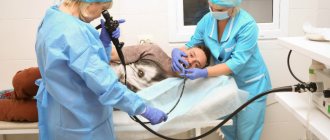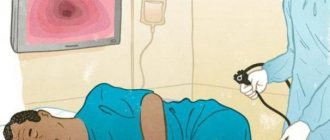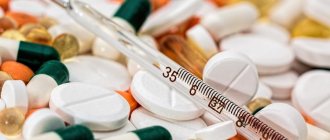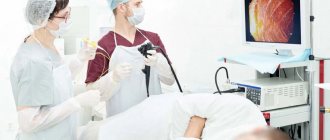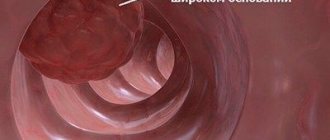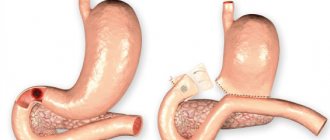FGDS stands for fibrogastroduodenoscopy. It means diagnostics of the digestive organs, which is carried out using a gastroendoscope.
This device displays a clear image of the internal state of the abdominal organs, thereby allowing you to make the correct diagnosis and formulate the necessary treatment. When an FGDS procedure of the stomach is necessary, it is also called “gastroscopy,” which refers to an examination of the stomach.
FGDS - what is this procedure?
FGDS is a modern examination method that allows you to assess the condition of the mucous membrane and identify the disease at the earliest stages. In addition to examination, the procedure makes it possible to collect material if a tumor is suspected. The method examines not only the stomach, but also the esophagus, intestines, and duodenum. The results of gastroscopy often serve as the basis for making a final diagnosis and determining treatment tactics. Gastroscopy of the stomach or other parts of the gastrointestinal tract is performed using endoscopic equipment - a gastroscope made of a long and flexible tube with a lens. It is administered through the mouth, and the doctor views the resulting image of the mucous membranes through a computer monitor.
Fibrogastroduodenoscopy is one of the most accurate diagnostic methods in gastroenterological practice. Thanks to the conclusion of FGDS, it is possible to identify a number of diseases in time and eliminate serious consequences. The method allows not only to assess the nature and localization of pathologies, but also to excise certain formations: polyps, erosions, material for biopsy.
Possible complications
Complications after gastroscopy are rare. In some patients, inflammation of the mucous membrane may occur for 1-3 days. After the procedure, you may feel drowsy and tired. In rare cases, bleeding occurs due to damage to the esophagus. You should definitely consult a doctor if the following complications of gastroscopy occur:
- Vomiting with blood;
- Labored breathing;
- Increased body temperature;
- Painful sensations in the abdomen.
In older people, gastroscopy increases the risk of heart attacks and strokes. Most often, patients with existing lung and heart problems are susceptible to this.
What is the difference between FGDS, EGDS and FGS?
| Procedure name | Spectrum of examination |
| Fibrogastroduodenoscopy (FGDS) | stomach, duodenum |
| Esophagogastroduodenoscopy (EGDS) | stomach, duodenum, esophagus |
| Fibergastroendoscopy (FGS) | stomach |
Indications for use
A referral for an FGDS is issued by the attending physician if the patient complains of certain symptoms to assess the functioning of the gastrointestinal tract, if a tumor of the gastrointestinal tract is suspected, or if medical and surgical interventions are performed. Among the main indications for FGDS are the following symptoms:
- pain, discomfort in the epigastric region of unknown etiology;
- frequent heartburn;
- bloating;
- a sharp decrease in body weight;
- constant belching not related to food intake;
- repeated vomiting;
- suspicion of intestinal bleeding;
- swallowing dysfunction.
Gastroscopy can also be prescribed for other unpleasant symptoms, as well as for monitoring treatment and the dynamics of the disease.
How is FGDS performed?
To understand how FGDS of the stomach is done, it is important to know that the procedure can be performed without anesthesia, under local anesthesia, or in a state of medicated sleep. The introduction of an anesthetic eliminates discomfort and reduces the urge to vomit. Many diagnostic centers offer the use of local anesthesia - treating the throat with lidocaine in the form of a spray.
The technique for performing FGDS consists of:
- the patient lies on the couch, on his side;
- the doctor inserts a plastic mouthpiece into the mouth - it helps prevent clenching of the mouth during the gag reflex;
- An endoscope is inserted through the mouthpiece, the patient is asked to take a deep breath;
- The endoscope tube is advanced into the esophagus and stomach.
After inserting the endoscope, the doctor examines the walls of the stomach, esophagus and intestines. The image is displayed on a computer monitor in real time. Thanks to modern equipment, during the study it is possible to obtain high-quality images that can be printed or sent to any medium. The FGDS transcript is sent to the attending physician, who uses the results obtained to make a diagnosis and prescribe the necessary treatment.
Using an endoscope, you can not only examine the upper gastrointestinal tract, but also administer medications to the affected area, stop internal bleeding or remove growths and tumors. According to indications, a biopsy or transendoscopic pH-metry can be performed.
How long an FGDS of the stomach lasts depends on the purpose of its implementation, but generally does not exceed 10-30 minutes. After it is performed, the patient remains in the clinic for 1-3 hours, then goes home.
The process of conducting FGDS
The probe must be inserted with extreme caution.
This procedure should only take place in a doctor's office. You must have a fiberscope, as well as a monitor on which the image will be displayed.
The patient should lie on his left side on a special couch. After which the doctor begins to slowly insert the probe into the patient’s mouth.
The probe is a thin cable that should not cause damage to the mucous membrane. There are cases when this examination is carried out through the nose.
In standard situations, the probe passes through the mouth, then into the esophagus, then into the stomach and only then into the duodenum. This procedure does not take much time, usually it lasts up to 15 minutes.
Upon completion, the doctor carefully removes the tube from the stomach. A patient who comes for such a procedure should not be afraid, since he will not experience pain.
In some cases, this procedure may be accompanied by unpleasant sensations. But in such situations, the doctor can numb the throat so that they don’t exist.
In certain situations, the doctor may use anesthesia. Thus, while in a dream, a person will undergo this procedure without feeling any unpleasant symptoms.
It is mainly done for children and restless patients.
The following video will tell you how to conduct gastroscopy examinations:
What diseases can be detected using FGDS?
Gastroscopy of the stomach and other parts of the gastrointestinal tract can identify a number of diseases, including:
- stomach and duodenal ulcers;
- varicose veins of the esophagus;
- polyps in the stomach;
- duodenitis;
- pancreatitis;
- gastroesophageal reflux;
- inflammatory processes on the walls of the stomach;
- damage to the colon;
- cholecystitis;
- oncological processes of benign or malignant origin.
The EGD procedure of the stomach is effective in stopping internal bleeding; in the presence of a foreign body in the digestive system, it allows one to identify its location and carry out removal.
results
The patient can receive the results of gastroscopy immediately after the examination. The conclusion will indicate whether there are pathologies such as gastrointestinal bleeding, peptic ulcer, esophagitis, gastroduodenitis, or any neoplasms.
Normally, the gastric mucosa is pale pink in color and a small amount of mucus accumulates in its folds. The pylorus ends in a black hole, which, when contracted, takes on a stellate shape. With pathologies, one of the following clinical pictures develops:
- The mucous membrane is red and swollen, the folds protrude - gastroduodenitis;
- The folds are smoothed out, the mucous membrane is gray in color - stomach cancer;
- A crater is formed above the mucous membrane, which is surrounded by a cushion - a peptic ulcer.
If the cardia is insufficient, the doctor concludes that there is a pathology in which incomplete closure of the valve occurs. Gastroesophageal reflux is indicated by the presence of bile in the stomach.
Preparing for the examination
To get the clearest images and make the study informative, the patient must prepare for it correctly. Not only physical, but also psychological preparation is considered important. For many, this procedure causes fear and anxiety due to the fact that without anesthesia, it causes a number of unpleasant symptoms and gag reflexes. To avoid fears, the doctor must, before the examination, convince the patient of the need to perform a gastroscopy, talk about the safety and information content of the procedure.
The main rules of preparation include:
- Compliance with the diet for 48 hours before gastroscopy. You should exclude fatty and spicy foods, foods that are difficult to digest, as well as those that cause bloating. You should also exclude foods that can injure the mucous membranes from your diet: nuts, honey, seeds, chocolate.
- A few days before FGDS, you should completely abstain from alcoholic beverages.
- Avoid smoking 2-3 hours before the test.
- If wearing dentures, remove them before the procedure.
- Performed on an empty stomach.
- If necessary, the doctor can prescribe enzyme preparations that will improve digestion, reduce flatulence and bloating: Espumisan, Pancreatin, Mezim.
- It is recommended to take a bulky napkin or towel with you for the examination.
- Swallowing is prohibited during the examination period.
- After performing the diagnosis, it is recommended to refrain from eating for 2 hours.
By following simple rules, FGDS of the gastrointestinal tract allows the doctor to obtain high-precision images in different projections, identify disorders, make the correct diagnosis, and prescribe the necessary therapy.
Contraindications
Despite the fact that the FGDS procedure is the “gold standard” in gastroenterology, this type of study has some contraindications, including:
- rachiocampsis;
- suspicion of a heart attack or early post-infarction period;
- poor blood clotting;
- vascular atherosclerosis;
- bronchial asthma during exacerbation;
- narrowing of the esophagus.
It is prescribed with great caution to patients who have a history of mental disorders, suffer from severe forms of hypertension, or have a history of diseases of the throat and tonsils. If there are limitations to diagnostics, the doctor looks for an alternative, this could be ultrasound, MRI.
Side effects after performing FGDS are rare, occurring in only 1% of patients. More often associated with a history of contraindications.
Gastroscopy is considered the best in diagnosing diseases of the gastrointestinal tract, but in order for the method to bring accurate results and the patient not to experience discomfort, it is important to choose the right clinic and doctor. Modern diagnostic centers are equipped with all necessary equipment. Doctors with extensive experience work here, who will not only conduct a high-quality examination, but also help with deciphering the results. You can sign up for the procedure by making an appointment on the clinic’s website or by phone. The administrator will select a time convenient for the patient, this will help avoid long queues.
FGDS - when not to do it
The FGDS procedure also has contraindications.
This examination cannot be carried out if the patient has a sore throat or has an acute respiratory disease. When is it necessary to sign up for an FGDS procedure:
- Body temperature remains at 38 degrees Celsius.
- Constant nausea, as well as vomiting, with which blood clots come out (in this situation, the color resembles dark chocolate).
- Defecation is difficult, and the stake is black (that is, there is a trace of blood in it).
- My stomach hurts all the time.
All this suggests that some abnormalities are developing in the body. To find out, you need to urgently visit a doctor who will prescribe this procedure.
